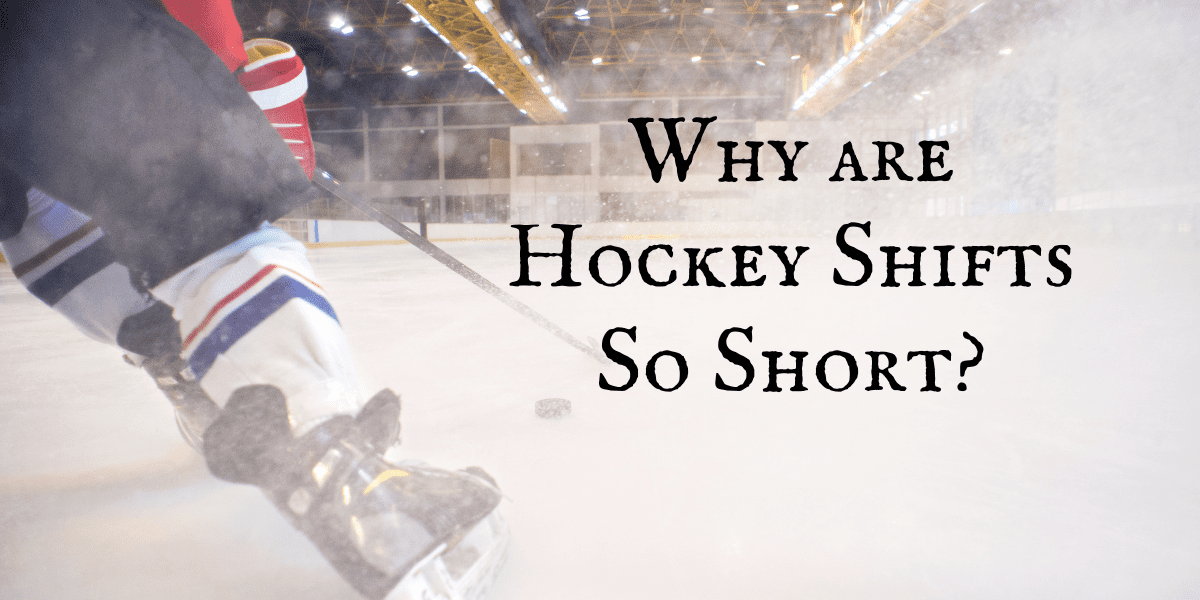Why Are Hockey Shifts So Short?
Over the past ten years as an Ice Hockey Parent, I have been fascinated by the unique aspects of ice hockey and the tactics used by players and coaches on the ice. One such aspect is the relatively short length of hockey shifts. While shifts in other team sports such as basketball or soccer can last several minutes, hockey shifts typically last a fraction of that time typically 30-90 seconds. In this section, we will explore the reasons behind this phenomenon and its impact on the game.
The average shift length in hockey varies depending on the situation but generally lasts between 30-60 seconds, the recommendation is not longer than 90 seconds. This is significantly shorter than the average playing time of many other sports. There are several reasons for this, including the physical demands of the sport, strategy, and the rules of the game.
Short shifts are a fundamental aspect of ice hockey that contributes to the fast-paced nature of the game.
By cycling players on and off the ice more frequently, teams can maintain a high level of intensity and speed, which can result in a competitive advantage.

Additionally, shorter shifts mean that players can maintain high energy levels, reducing the risk of fatigue and improving overall performance.
Overall, there are several compelling reasons why hockey shifts are so short. By understanding these factors, we can gain insights into the strategies and tactics used by coaches and players on the ice.
Key Takeaways:
- Hockey shifts are typically shorter than other team sports, lasting between 30-60 seconds.
- The physical demands of the sport, strategy, and rules of the game all contribute to short shifts.
- Shorter shifts help teams maintain a high level of intensity and speed, reducing the risk of fatigue and improving overall performance.
- Cycling players on and off the ice more frequently contributes to the fast-paced nature of the game.
- By understanding the reasons behind short shifts, we can better appreciate the uniqueness of ice hockey as a sport.
The Average Shift Length in Hockey
As I mentioned earlier, one of the unique aspects of hockey is the relatively short length of a player’s time on the ice, known as a shift. So, what is the average shift length in hockey?
On average, a hockey player’s shift lasts between 30 and 50 seconds, with some elite players occasionally staying on for up to 90 seconds. This may seem brief, but given the intensity and physical demands of the sport, players need to maintain maximum effort and focus during their time on the ice.
In terms of minutes of ice time, players typically play between 15 and 20 minutes per game, with some top players reaching up to 25 minutes. It’s worth noting that this is significantly less than the playing time in other sports, such as soccer or basketball, where players may be on the field or court for the majority of the game.
To put this in perspective, consider that there are six players on a hockey team, meaning that a player may only be on the ice for a little over two minutes per shift before they’re replaced by a teammate.
This constant rotation allows for fresh legs and maximum effort throughout the game.

Factors Influencing Short Shifts
In hockey, the duration of a shift is crucial. It can mean the difference between a well-rested player making a game-winning play or a fatigued player causing a costly mistake. Several factors influence the length of a shift, including:
- Line changes
- Power plays
- Penalty kills
- Player rotation
- Ice hockey substitutions
Let’s take a closer look at each of these factors:
Line Changes
Line changes occur when a coach decides to swap out one set of players for another. This strategy allows players to rest and recover, maintaining their intensity throughout the game. On average, a hockey game can have up to 60 line changes, resulting in shorter shift durations.
Power Plays and Penalty Kills
Power plays and penalty kills are two situations where specific players are designated to handle the puck. These situations require intense focus, and players need to be well-rested to execute their roles effectively. Coaches often use shorter shifts during these times to ensure their players have the energy needed to perform optimally.
Player Rotation
Strategic player rotation involves coaches swapping out players based on their roles and specialties. For example, a coach might use a certain player during faceoffs or when attempting to score. This type of rotation keeps players fresh, allowing them to give their best performance throughout the game.
Ice Hockey Substitutions
Finally, ice hockey substitutions are also a factor that affects the length of a shift. Players can only enter or exit the game when there is a stoppage in play, which means shorter shifts are necessary to ensure players get adequate rest and recovery time between plays.
By understanding the various factors that influence the length of hockey shifts, we can appreciate the strategies employed by coaches and the unique demands placed on players in this exciting sport.

The Impact of Short Shifts on the Game
In ice hockey, the duration of shifts is not only a physical consideration but also a strategic one. Short shifts have a significant impact on the game, influencing player performance and team strategy. Let’s explore the different ways that short shifts affect the game of hockey.
Fresh Legs
One essential advantage of shorter shifts is the ability for players to maintain fresh legs throughout the game. By having fewer minutes on the ice, players can maintain high energy levels and contribute to the team’s overall performance. The advantage of fresh legs becomes particularly apparent in the third period, where fatigue can significantly impact players’ performance. Short shifts, therefore, allow players to maintain their energy while maximizing their time on the ice.
Tired Players
On the other hand, players who remain on the ice for an extended period can quickly become fatigued. When players become tired, their reaction times slow down, and their overall performance declines. This decline in performance can lead to mistakes on the ice, which can ultimately impact the game’s outcome. Shorter shifts help to mitigate this risk, allowing coaches to keep players fresh and focused on the game.
Strategic Reasons
Short shifts also serve a strategic purpose in ice hockey. Coaches may use shorter shifts strategically to disrupt the opposing team’s momentum, create offensive opportunities, or deploy specific players in critical moments of the game. The ability to make quick and frequent line changes gives coaches a powerful tool to manage the game’s pace and adjust their strategy in real-time.
As we’ve seen, short shifts have a significant impact on the game of hockey, affecting both player performance and strategic decision-making. By understanding the dynamics of short shifts, we can appreciate the critical role they play in the game’s overall strategy.
Conclusion
After exploring the reasons behind short hockey shifts, we now have a new look at this fast-paced, physical sport. It’s clear that the relatively short duration of shifts in hockey is due to factors such as line changes, power plays, and the need for players to maintain maximum intensity.
Short shifts have a significant impact on the game, as they allow players to have fresh legs on the ice and make strategic decisions about player rotations. However, they also present challenges for tired players who may struggle to maintain their performance.
Despite these effects, hockey shifts duration remains a unique aspect of the sport, and by understanding why they are so short, we can better appreciate the skills and tactics involved in ice hockey.
FAQ
Why are hockey shifts so short?
Hockey shifts are typically short for several reasons. The fast-paced nature of the game requires players to exert maximum effort and intensity during their time on the ice. Shorter shifts allow players to maintain this level of performance and prevent fatigue. Additionally, strategic reasons such as line changes, power plays, penalty kills, and player rotations also contribute to the shorter shift durations in hockey.
What is the average shift length in hockey?
The average shift length in hockey varies depending on various factors, but it typically falls between 30 to 60 seconds. This duration allows players to give their all during their time on the ice and ensures a constant flow of fresh legs to maintain the speed and intensity of the game.
What factors influence short shifts in hockey?
There are several factors that influence the duration of hockey shifts. Line changes are a common reason for short shifts as teams strategically rotate their players to keep them rested and maximize their performance. Power plays and penalty kills also result in shorter shifts as teams aim to take advantage of the extra player or defend against the opposition’s power play. Additionally, coaches may implement strategic player rotations to optimize performance and match-ups against the opposing team.
What is the impact of short shifts on the game?
Short shifts have a significant impact on the game of hockey. By ensuring players have fresh legs on the ice, teams can maintain a high level of speed and intensity throughout the game. This contributes to a more exciting and dynamic gameplay. Tired players are more prone to making mistakes, so shorter shifts help prevent fatigue and maintain the quality of play. Coaches also utilize shorter shifts strategically for specific game situations and to exploit favorable match-ups against the opposition.



